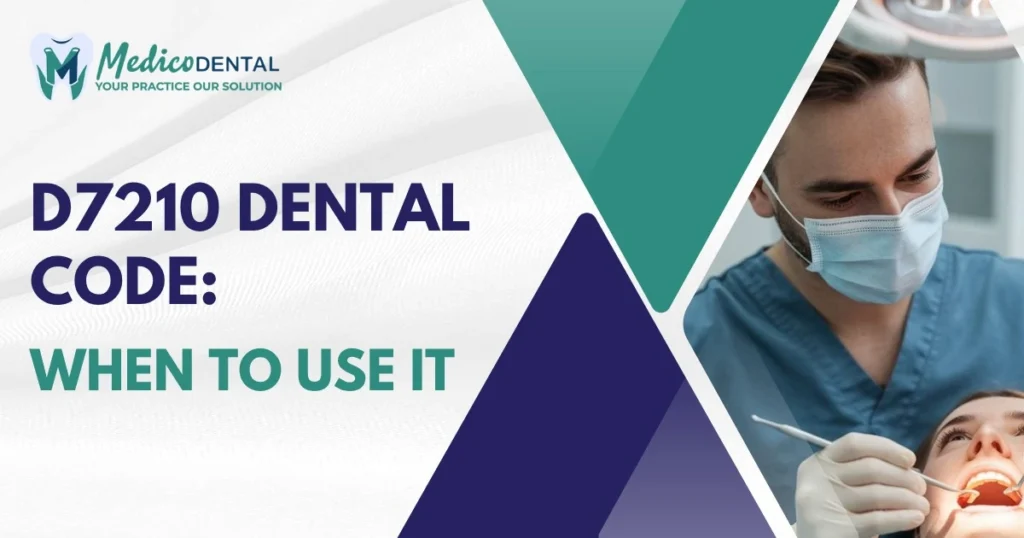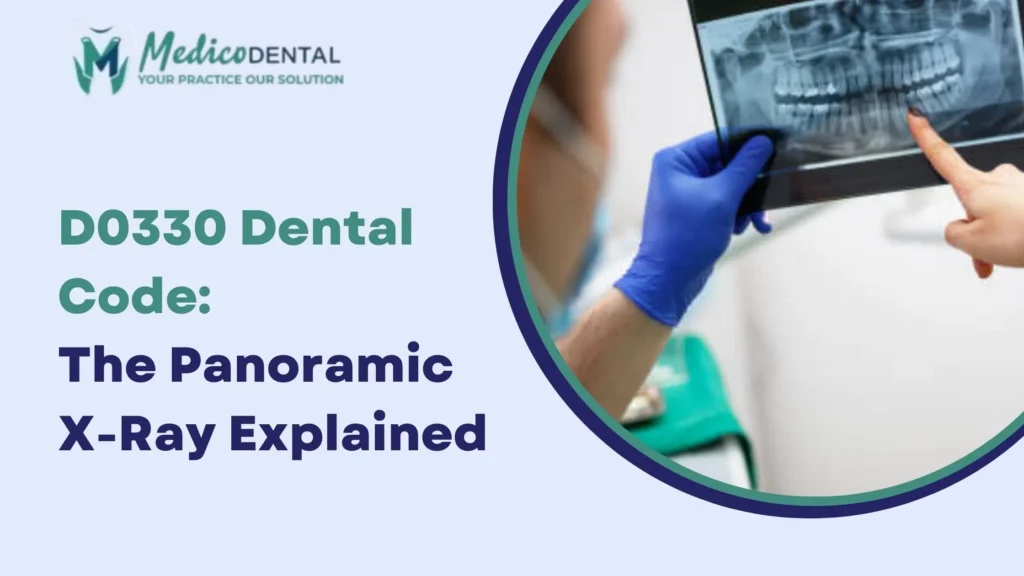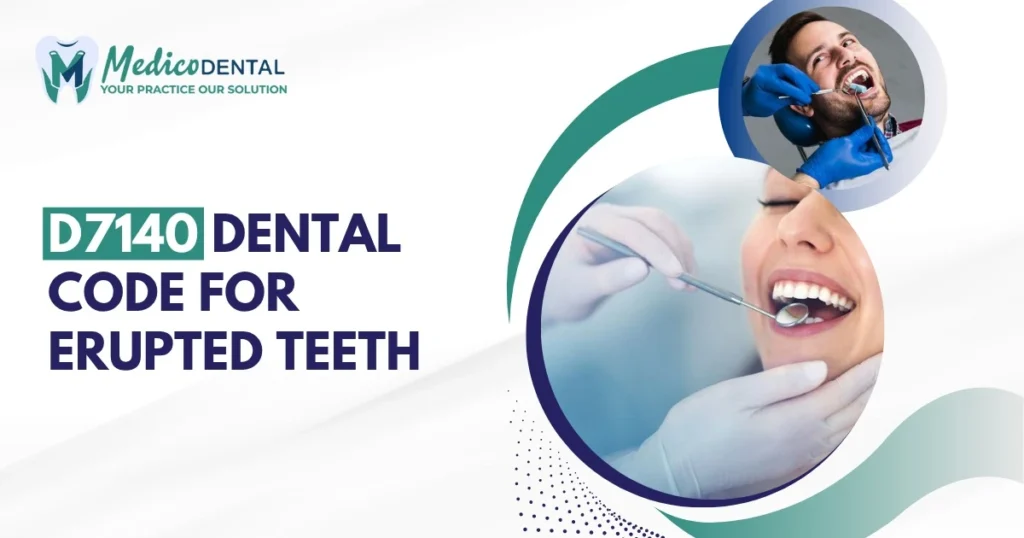The D7210 dental code is one of the most important and commonly used CDT codes in oral surgery, representing the surgical removal of an erupted tooth that requires extra steps beyond a simple extraction. Understanding this code is essential for dentists, billing teams, and patients alike, as it directly affects treatment documentation, insurance claims, and reimbursement accuracy. This guide explains everything you need to know about the D7210 dental code from its clinical purpose and procedure details to correct billing practices and common coding mistakes to help ensure precision, compliance, and fair compensation in dental care.
What Is the D7210 Dental Code?
Definition and Meaning of D7210 in Dentistry
The D7210 dental code represents a specific surgical extraction procedure officially defined by the American Dental Association (ADA) as the “surgical removal of erupted tooth requiring elevation of mucoperiosteal flap and removal of bone and/or sectioning of tooth.”
In simple terms, this code applies when a dentist must perform a surgical extraction rather than a basic one. The procedure involves lifting the gum tissue, possibly removing some bone, and sometimes cutting the tooth into sections to remove it safely and completely.
The D7210 code is used when a standard extraction (such as D7140) isn’t enough due to tooth anatomy, complexity, or underlying oral conditions. It helps dental offices properly document and bill for the additional surgical skill, time, and instruments involved in this procedure.
When and Why D7210 Dental Code Is Used
Dentists use the D7210 dental code when a tooth is erupted meaning visible in the mouth but cannot be extracted through simple forceps removal. Common reasons include:
- The tooth has curved or multiple roots that make removal complex.
- The tooth has extensive decay or has fractured at the gum line, making it difficult to grip.
- Bone must be removed or the tooth must be sectioned for safe removal.
- The extraction requires a mucoperiosteal flap (lifting gum tissue) to access the root and bone.
Essentially, D7210 is used when the dentist performs more than a simple extraction, turning it into a surgical one due to anatomical or pathological challenges.
How D7210 Differs from Simple Extraction Codes
The most common point of confusion occurs between D7140 (simple extraction) and D7210 (surgical extraction).
- D7140 applies when the tooth is fully erupted and can be removed easily without cutting into the gum or bone.
- D7210, however, applies when the dentist must elevate the gum tissue, remove bone, or section the tooth to complete the extraction.
Using the correct code ensures proper reimbursement and compliance with ADA and insurance requirements. Overcoding or undercoding either can lead to claim denials or underpayment.
Purpose and Importance of the D7210 Dental Code
Clinical Scenarios Requiring D7210 Procedure
The D7210 dental code is often used in situations where simple extractions become surgically complicated. Common examples include:
- Teeth with hypercementosis, fused roots, or ankylosis (tooth fused to bone).
- Previously root canal treated teeth, where the structure is brittle or the roots are complex.
- Fractured crowns where gripping the tooth is impossible without flap elevation.
- Periodontally compromised teeth with bone irregularities.
- Erupted third molars (wisdom teeth) requiring flap access and bone removal.
These cases typically require more time, skill, and instrumentation, which justifies the use of D7210.
Role of the D7210 Dental Code in Complex Extractions
The D7210 code allows dentists to differentiate routine extractions from surgical extractions that demand higher technical precision.
By using D7210, practitioners clearly communicate the complexity and surgical nature of the treatment to both patients and insurance payers.
Accurate use of this code ensures that dentists are fairly compensated for the surgical techniques performed and that insurers recognize the medical necessity of the procedure.
Benefits of Accurate D7210 Coding for Dental Practices
Using the D7210 dental code correctly has multiple advantages:
- Ensures proper reimbursement for surgical effort and resources used.
- Reduces the risk of claim rejections or audits.
- Supports transparent communication with patients about the complexity and cost of treatment.
- Promotes compliance with ADA and payer documentation standards.
Accurate coding not only protects the practice financially but also improves patient understanding of their care and costs.
Step by Step Guide to the D7210 Dental Procedure
Patient Preparation and Anesthesia
The procedure begins with clinical and radiographic evaluation to assess the tooth’s position, root structure, and surrounding bone. Local anesthesia is administered to ensure patient comfort. In some cases, sedation may be used for anxious patients or complex extractions.
Elevation of the Mucoperiosteal Flap
Once anesthesia takes effect, the dentist makes a small incision in the gum tissue and gently lifts the mucoperiosteal flap. This step exposes the underlying bone and provides clear access to the tooth root.
Bone Removal and Tooth Sectioning
If bone partially covers the tooth or obstructs access, the dentist removes a small portion of bone using a surgical bur.
In difficult cases especially when roots are curved or fused the tooth may be sectioned into smaller parts to minimize trauma and allow easier removal.
Extraction and Site Closure Steps
After removing all tooth sections, the dentist smooths the bone and thoroughly irrigates the area to remove debris. The flap is repositioned and sutured to promote proper healing.
Post operative care instructions are given, including pain management, oral hygiene tips, and follow up appointments.
D7210 Dental Code vs Other Extraction Codes
D7140 vs D7210 Key Differences
- D7140: Simple extraction of an erupted tooth. No bone removal or tooth sectioning.
- D7210: Surgical extraction of an erupted tooth involving flap elevation, bone removal, or sectioning.
If a procedure begins as a simple extraction but becomes surgical due to unexpected complexity, the provider should document the additional steps and bill D7210 instead of D7140.
D7210 vs D7220, D7230, and D7240
Other extraction codes relate primarily to impacted teeth:
- D7220: Removal of an impacted tooth soft tissue only.
- D7230: Removal of a partially bony impacted tooth.
- D7240: Removal of a completely bony impacted tooth.
D7210, by contrast, applies to erupted teeth that still require surgical intervention not impacted ones. Understanding this difference prevents miscoding and claim issues.
How to Choose the Correct Extraction Code
The correct code depends on:
- Whether the tooth is erupted or impacted.
- The degree of bone removal required.
- Whether the procedure involved flap elevation or tooth sectioning.
Clear clinical documentation and radiographs support the code selection and justify the surgical nature of the extraction.
Documentation and Coding Guidelines for D7210 Dental Code
Essential Documentation for Accurate Billing
To support a D7210 claim, documentation should include:
- Detailed clinical notes describing flap elevation, bone removal, or tooth sectioning.
- Pre operative radiographs confirming the tooth’s complexity.
- Narrative justification describing why the extraction was surgical rather than simple.
- Post operative notes confirming suture placement or flap repositioning.
These details are crucial for insurance verification and claim approval.
ADA and Insurance Reporting Standards
The ADA requires that D7210 be used only for erupted teeth when surgical access, bone removal, or sectioning is performed.
Insurance companies often follow ADA guidelines but may request:
- X rays showing the tooth structure and surrounding bone.
- Operative notes confirming surgical steps.
- Justification when switching from a simple to a surgical code mid procedure.
Following these standards helps prevent claim delays and denials.
Common Coding Errors in D7210 Claims
Some of the most frequent coding mistakes include:
- Using D7210 for impacted teeth (should use D7220–D7240 instead).
- Failing to document bone removal or flap elevation, leading to down coding.
- Submitting D7140 instead of D7210 even when surgical techniques were performed.
- Omitting narrative explanations, causing insurance claim rejection.
Avoiding these errors ensures compliance and maximizes reimbursement accuracy.
Billing and Insurance Aspects of the D7210 Dental Code
Typical Cost and Insurance Reimbursement
The cost of the D7210 dental code can vary significantly depending on several factors, including the geographic location, provider experience, and the complexity of the extraction. On average, a D7210 procedure can range from $250 to $500 per tooth without insurance.
For patients with dental insurance, most plans cover D7210 as a basic or major service, depending on the policy. Coverage typically includes 50%–80% of the procedure fee after the deductible is met.
However, reimbursement amounts can vary depending on whether the dentist is in network or out of network with the insurance provider.
From the billing perspective, it’s important that the clinical documentation clearly supports the surgical nature of the procedure such as bone removal, flap elevation, or tooth sectioning since insurance companies often review the justification before approving payment.
Coverage Policies and Preauthorization Tips
While many insurance plans recognize D7210, coverage policies can differ based on the insurer. Some carriers may require preauthorization before the surgical extraction to confirm that it’s medically necessary.
Best practices for preauthorization include:
- Submitting detailed radiographs showing the condition of the tooth and surrounding bone.
- Providing a written narrative explaining why a surgical approach was necessary.
- Including any previous treatment history, such as failed simple extractions or crown fractures.
Preauthorization doesn’t guarantee payment, but it provides a record that the procedure was reviewed and medically approved. This minimizes the risk of post treatment claim denials.
How to Avoid D7210 Claim Denials
Claim denials for D7210 often occur because of insufficient documentation or incorrect code selection.
To prevent these issues, follow these steps:
- Ensure that the tooth is erupted (visible in the mouth); otherwise, a different code (D7220–D7240) should be used.
- Include pre and post operative radiographs with the claim submission.
- Provide a clear clinical narrative describing the surgical steps (flap elevation, bone removal, or sectioning).
- Double check that the claim matches clinical notes and ADA documentation guidelines.
Accurate documentation not only helps justify the code but also improves claim approval rates and prevents re submission delays.
Clinical Criteria for Using the D7210 Dental Code
Determining When a Surgical Extraction Is Justified
The D7210 dental code should only be used when surgical techniques are required to remove an erupted tooth.
This is typically justified in situations such as:
- The tooth has complex or curved roots that make a simple extraction impossible.
- The crown has fractured at the gum line, preventing standard forceps removal.
- The tooth is surrounded by dense bone, requiring bone removal.
- A mucoperiosteal flap must be elevated to gain access to the root or bone.
If these conditions are not present, the correct code is D7140, representing a simple extraction.
Radiographic and Clinical Evidence Requirements
Insurance carriers and auditors rely heavily on radiographic proof and clinical notes to verify the necessity of using D7210.
Acceptable evidence includes:
- Pre treatment X rays showing root structure, bone density, or fractures.
- Intraoral photos or notes confirming the need for surgical access.
- Detailed procedure notes documenting flap elevation, bone removal, or tooth sectioning.
The clearer the evidence, the stronger the claim support and the smoother the reimbursement process.
Importance of Medical Necessity Documentation
Medical necessity is the foundation of every successful D7210 claim. To demonstrate it, the dentist should document why a simple extraction would have been insufficient.
Examples include:
- The tooth was ankylosed or fused to the bone.
- Heavy bone coverage prevented normal extraction.
- Root fragments required surgical exposure.
By clearly explaining the medical necessity in the patient record and claim narrative, providers can justify both the treatment and the code selection to insurers.
Best Practices for Submitting D7210 Dental Code Claims
Accurate Coding for Faster Reimbursements
Accuracy is everything in dental billing. To ensure timely reimbursement for D7210 procedures, dental offices should:
- Verify that the tooth was erupted, not impacted.
- Confirm the inclusion of flap elevation, bone removal, or sectioning in the clinical notes.
- Ensure that the billing software and ADA claim form reflect the correct CDT code and tooth number.
The more precise your documentation, the faster and smoother your payment cycle will be.
Supporting Notes and Radiographs
Supporting documentation is critical for D7210 claim success. Always include:
- Pre operative X rays (to confirm condition).
- Operative notes (detailing surgical steps).
- Post operative radiographs or images, when applicable.
- Narrative summaries explaining the reason for surgical extraction.
These materials collectively provide insurers with a clear clinical justification for the D7210 code, minimizing the likelihood of denials.
Role of Professional Dental Billing Services
Working with professional dental billing services can significantly reduce coding and submission errors.
Experts familiar with ADA coding standards and payer requirements ensure that:
- Claims are properly documented and formatted.
- Narratives are clear, concise, and compliant.
- Denied or underpaid claims are appealed effectively.
By outsourcing to professionals, dental practices can focus more on patient care while ensuring their revenue cycle runs smoothly and efficiently.
Common Mistakes and Misuse of the D7210 Dental Code
Overcoding and Undercoding Issues
One of the biggest compliance risks in dental billing is using the wrong code for extractions.
- Overcoding occurs when D7210 is billed even though no surgical steps were performed.
- Undercoding happens when a procedure involved surgical techniques, but the simpler D7140 was used.
Both errors can cause financial and compliance issues. Overcoding may lead to insurance audits, while undercoding results in lost revenue.
Misidentifying Surgical vs Simple Extractions
Many billing errors stem from confusion between surgical and simple extractions.
A simple extraction (D7140) involves loosening and removing a tooth without cutting into the gum or bone.
A surgical extraction (D7210) requires gum elevation, bone removal, or tooth sectioning.
To determine the correct code, review the operative notes carefully and ensure that the procedure performed aligns with ADA definitions.
Tips to Ensure Compliance and Accuracy
To maintain compliance and protect reimbursement:
- Train staff regularly on CDT code updates and ADA definitions.
- Maintain consistent documentation practices across all providers.
- Perform periodic audits of extraction codes to identify recurring errors.
- Keep clear communication between clinical and billing teams to ensure all surgical steps are properly captured.
Consistent documentation and review processes help prevent costly mistakes and ensure ethical billing practices.
Conclusion
The D7210 dental code represents more than just a billing line item it reflects a complex surgical procedure requiring precision, skill, and clear documentation.
Accurately applying this code ensures that both patients and providers are treated fairly: patients understand the complexity and necessity of their care, while providers receive appropriate reimbursement for their surgical expertise.
In today’s insurance driven dental environment, success depends on accurate coding, thorough documentation, and strong communication between the clinical and billing teams.
By mastering the correct use of D7210, dental practices can minimize claim denials, maintain compliance with ADA guidelines, and streamline their revenue cycle all while delivering the best patient care possible.
FAQs
What is the D7210 dental code?
Ans. It refers to the surgical removal of an erupted tooth requiring gum elevation, bone removal, or tooth sectioning.
How is D7210 different from D7140?
Ans. D7140 is a simple extraction, while D7210 involves surgical steps like flap elevation or bone removal.
When should D7210 be used?
Ans. Use D7210 when an erupted tooth requires surgery due to complex roots, fractures, or bone interference.
How much does a D7210 procedure cost?
Ans. It typically costs $250–$500 per tooth, depending on complexity and insurance coverage.
Does insurance cover D7210?
Ans. Yes, most plans cover it as a basic or major service, often requiring preauthorization.



